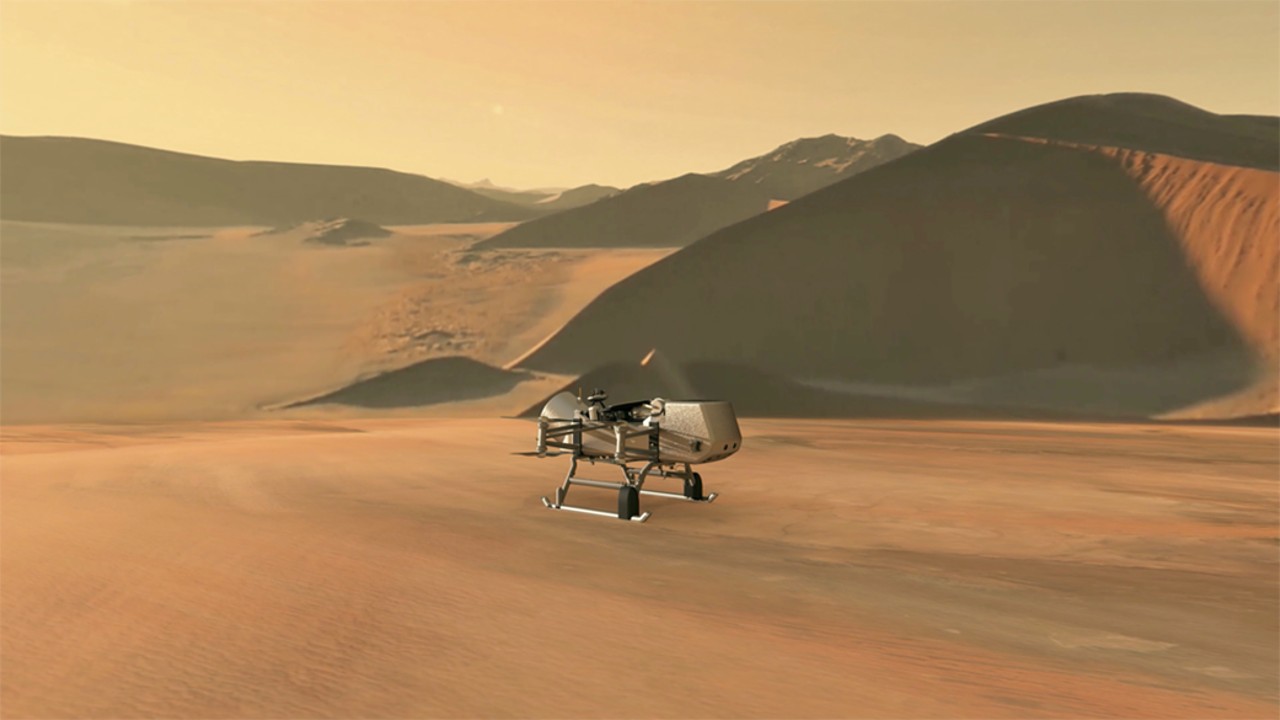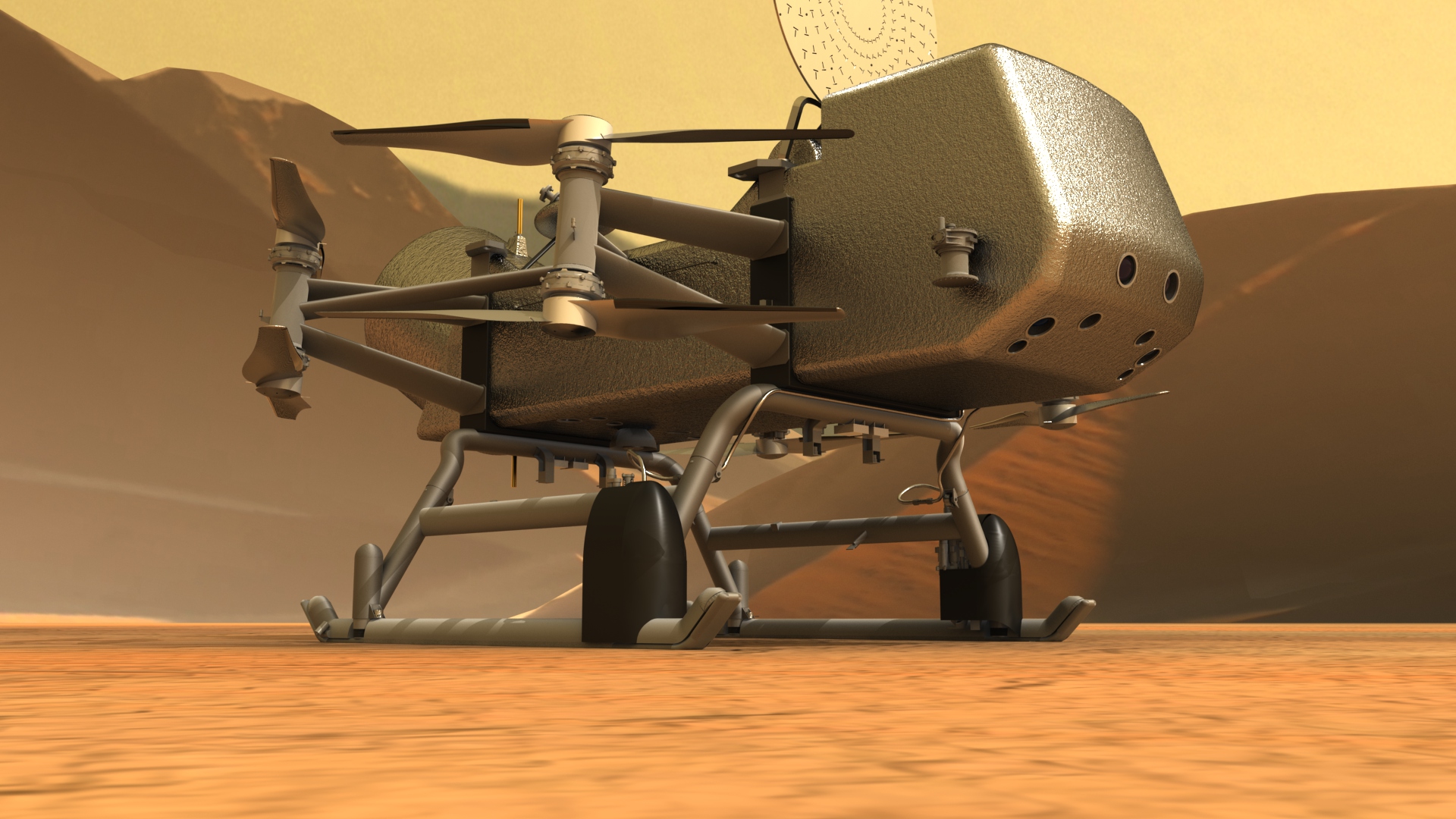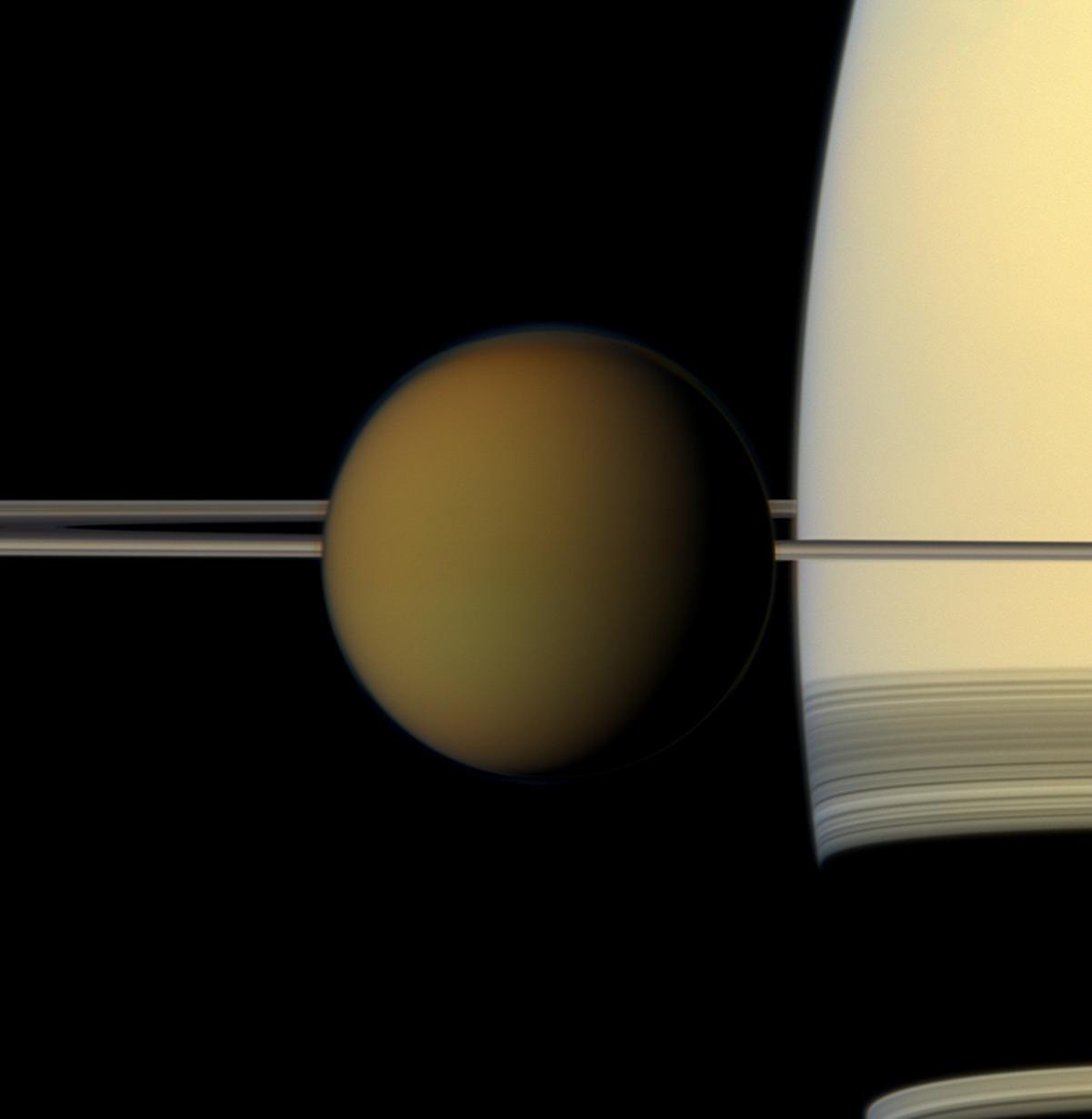Saturn moon Titan could hold the clues to life's origin. This NASA drone could find them
The Dragonfly rotorcraft-lander will be one of NASA's most diversely capable planetary exploration craft.

The fourth in a line of groundbreaking NASA missions that could redefine how we understand life in the universe is set to launch in 2027.
NASA's Dragonfly drone is headed for Saturn's largest moon, Titan, an active, icy world with a nitrogen-rich atmosphere and underground liquid-water oceans, where the skies rain methane to fill lakes and flowing rivers on the surface. Dragonfly is poised to get an up-close look at all of it, and possibly discover clues to the origins of life on the moon.
Dragonfly will be NASA's first interplanetary rotorcraft-lander probe outfitted with a full suite of scientific instruments, and will be capable of flying several miles between geological points of interest on Titan's surface. Currently being designed and built at the Johns Hopkins Applied Physics Laboratory in Laurel, Maryland, Dragonfly is part of NASA's New Frontiers program, which includes the OSIRIS-REx probe's study of the asteroid Bennu, Juno, sent to orbit Jupiter, and the New Horizons probe that performed a fly-by of Pluto and is now studying the Kuiper Belt.
Related: Titan: Facts About Saturn's Largest Moon
Saturn's largest moon also happens to be the second largest moon in the solar system, with Titan weighing in just behind Jupiter's moon, Ganymede. As a planetary body, Titan is larger than Mercury, with an atmosphere quadruple the density of Earth's. Its size and lower gravity, paired with the moon's thick atmosphere make it the perfect candidate for a robotic explorer like Dragonfly.
Another drone is already in-use by the space agency on the surface of Mars. Measuring only a few feet (about a meter) across its rotors, Ingenuity arrived on the red planet stowed beneath the Perseverance rover and became the first human-built craft to perform aerodynamically controlled flight on an alien world. The Martian helicopter was originally sent just for a series of test flights, but performed well enough that NASA decided to extend its mission as a scout for its rover companion.
Ingenuity is only equipped with cameras and a few basic instruments to ensure vehicle health and flight performance. When Dragonfly arrives at Titan, it will be carrying an entire laboratory. Because of Titan's geological diversity, Dragonfly is being designed to test the gamut of the moon's properties, including its atmospheric composition and the chemical makeup of its differing liquid bodies above and below ground.
Get the Space.com Newsletter
Breaking space news, the latest updates on rocket launches, skywatching events and more!

In addition, the drone will analyze samples extracted from Titan's surface. Dragonfly will use the Drill for Acquisition of Complex Organics (DrACO) instrument to dig out surface material less than a gram at a time. These specimens will be stored and analyzed internally, inside part of the lander's main body known as the "attic". Dragonfly's attic houses another instrument, called the Dragonfly Mass Spectrometer (DraMS). DraMS works similarly to the Sample Analysis at Mars (SAM) spectrometer built into the Mars Curiosity rover, and was designed by the same team at NASA's Goddard Space Flight Center.
The spectrometer works to identify the chemical composition of a sample by breaking down its molecular makeup through a process of ionization (which involves vaporizing samples with a laser inside a tiny onboard oven) that allows DraMS to examine a specimen's individual compounds. What exactly makes up the surface of Titan may have enormous implications for astrobiology researchers, scientists and humanity as a whole.

Scientists plan to use DrACO and DraMS to probe Titan's extraterrestrial environment to determine its habitability and search for the type of chemical markers indicative of life, or pre-life. Dr. Melissa Trainer is NASA's project lead on the DraMS instrument, and is one of the researchers hoping clues to the beginning of life on Earth can be found on the Saturnalian moon. "We want to know if the type of chemistry that could be important for early pre-biochemical systems on Earth is taking place on Titan," Trainer said in a NASA statement.
When it launches in 2027, Dragonfly will have to contend with a journey through interplanetary space nearly seven years long. If everything goes smoothly, when Dragonfly finally touches down on Titan's surface, sometime during 2034, the rotorcraft-lander will have at least 32 months (2.7 years) to complete its mission. If everything goes very smoothly, and Dragonfly follows in the successes of continued missions like New Horizons, Juno, Curiosity, or its rotary-predecessor Ingenuity, it's possible for the lander's expedition of Titan to go beyond 32 months.
Follow us @Spacedotcom, or on Facebook and Instagram.
Join our Space Forums to keep talking space on the latest missions, night sky and more! And if you have a news tip, correction or comment, let us know at: community@space.com.

Josh Dinner is the Staff Writer for Spaceflight at Space.com. He is a writer and photographer with a passion for science and space exploration, and has been working the space beat since 2016. Josh has covered the evolution of NASA's commercial spaceflight partnerships and crewed missions from the Space Coast, as well as NASA science missions and more. He also enjoys building 1:144-scale model rockets and human-flown spacecraft. Find some of Josh's launch photography on Instagram and his website, and follow him on X, where he mostly posts in haiku.









